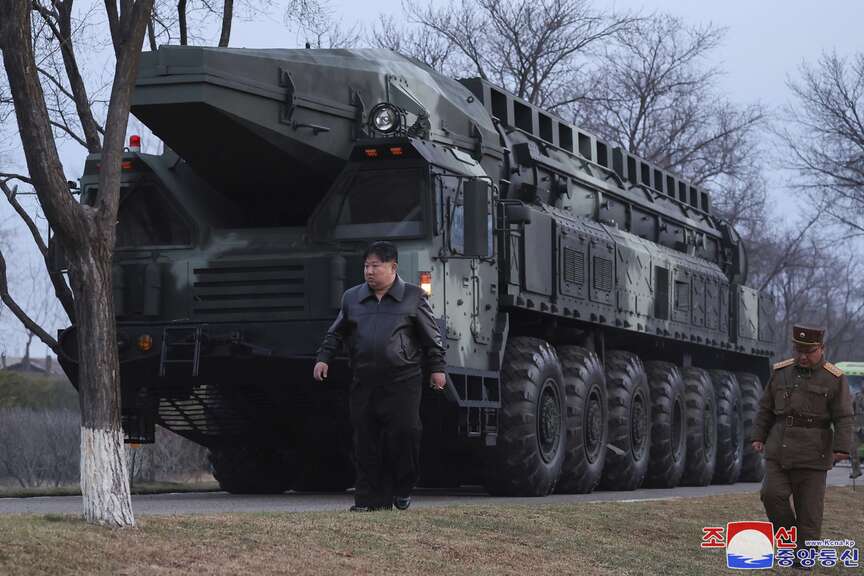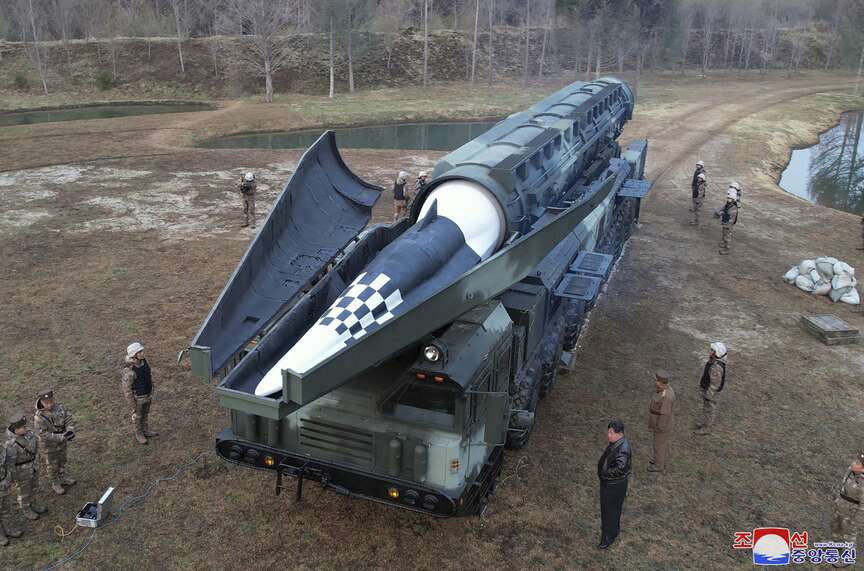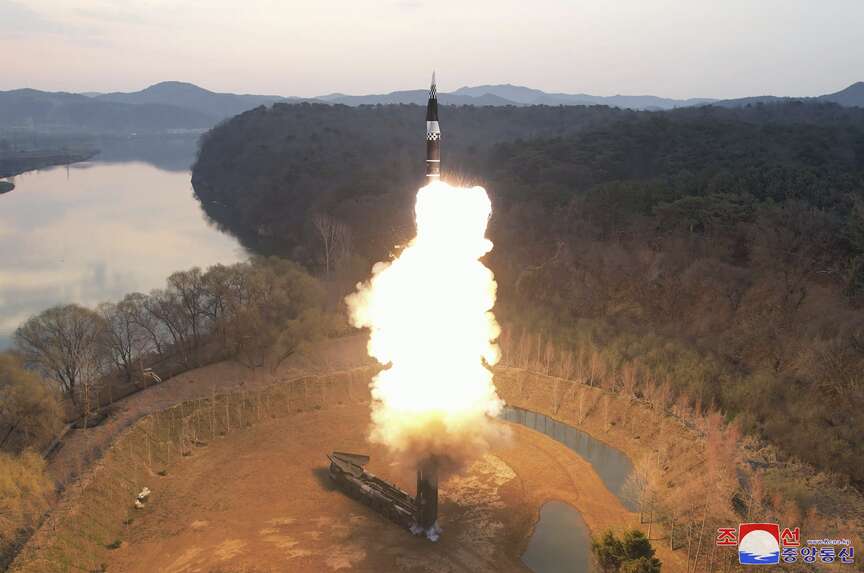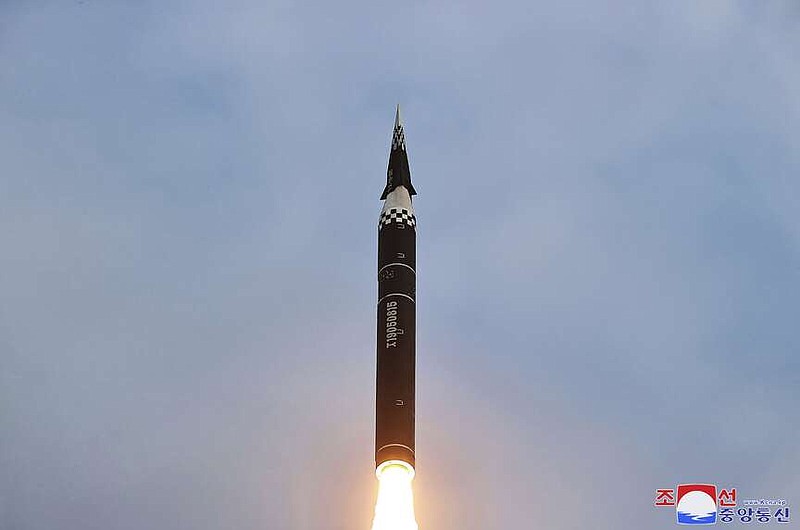SEOUL, South Korea -- North Korea said Wednesday it had tested a new hypersonic intermediate-range missile powered with solid propellants, extending a run of weapons tests that's deepening a nuclear standoff with neighbors and the United States.
With the supposed success of the demonstration, North Korean leader Kim Jong Un declared his country had acquired the ability to build solid-fuel, nuclear-capable missiles of all ranges as he pursues an arsenal that can credibly threaten rivals in Asia and the United States.
But the South Korean military said the North is exaggerating the success of the test and its overall missile prowess.
The report by North Korean state media came a day after the South Korean and Japanese militaries detected a missile launched from near the North's capital toward its eastern sea.
State media said the test was supervised by Kim, who described the Hwasong-16B missile as a key piece of his nuclear deterrent he vowed to further build up to counter his "enemies," a reference to the United States, South Korea and Japan.
In recent years, North Korea has been developing more missiles with built-in solid propellants. Such weapons are easier to move and hide, and can be launched quicker than liquid-propellant missiles, which need to be fueled before launch and cannot stay fueled for long periods of time.
North Korea tested a solid-fuel intercontinental ballistic missile for the first time last year, adding to its arsenal of long-range weapons targeting the U.S. mainland. The country also has an extensive lineup of short-range and mid-range solid-fuel missiles that can be fired from land vehicles, ships and submarines and are potentially capable of hitting targets throughout South Korea and Japan. In recent months, the North demonstrated some of these missiles in drills it described as simulated nuclear strikes.
Since 2021, it's also been testing hypersonic weapons designed to fly at more than five times the speed of sound. If perfected, such systems could potentially pose a challenge to regional missile defense systems because of their speed and maneuverability. However, it's unclear whether these missiles are consistently flying at the speeds the North claims.
North Korean official media KCNA claimed that during the Tuesday test, the missile's hypersonic glide warhead reached a peak altitude of 62 miles and flew about 621 miles after separating from the launch rocket, and performed various maneuvers before landing in waters between the Korean Peninsula and Japan.
South Korea's Joint Chiefs of Staff on Wednesday maintained its assessment that the missile flew about 372 miles and accused North Korea of exaggerating the missile's flight performance, although acknowledging that the North's technologies were improving. The previous day, Japan reported a similar flight distance, although its Defense Ministry reported a maximum height close to that claimed by the North.
The Joint Chiefs of Staff said it remains unclear whether the North has perfected the technologies to ensure that the warheads of its hypersonic solid-fuel missiles and intercontinental ballistic missiles survive the harsh conditions of atmospheric re-entry.
Information for this article was contributed by Hyung-jin Kim of The Associated Press.
 In this photo provided by the North Korean government, North Korean leader Kim Jong Un, center, walks by what they call an intermediate-range ballistic missile on the outskirts of Pyongyang, North Korea Tuesday, April 2, 2024. Independent journalists were not given access to cover the event depicted in this image distributed by the North Korean government. The content of this image is as provided and cannot be independently verified. Korean language watermark on image as provided by source reads: "KCNA" which is the abbreviation for Korean Central News Agency. (Korean Central News Agency/Korea News Service via AP)
In this photo provided by the North Korean government, North Korean leader Kim Jong Un, center, walks by what they call an intermediate-range ballistic missile on the outskirts of Pyongyang, North Korea Tuesday, April 2, 2024. Independent journalists were not given access to cover the event depicted in this image distributed by the North Korean government. The content of this image is as provided and cannot be independently verified. Korean language watermark on image as provided by source reads: "KCNA" which is the abbreviation for Korean Central News Agency. (Korean Central News Agency/Korea News Service via AP) In this photo provided by the North Korean government, North Korean leader Kim Jong Un, front center, stands by what they call an intermediate-range ballistic missile, on the outskirts of Pyongyang, North Korea Tuesday, April 2, 2024. Independent journalists were not given access to cover the event depicted in this image distributed by the North Korean government. The content of this image is as provided and cannot be independently verified. Korean language watermark on image as provided by source reads: "KCNA" which is the abbreviation for Korean Central News Agency. (Korean Central News Agency/Korea News Service via AP)
In this photo provided by the North Korean government, North Korean leader Kim Jong Un, front center, stands by what they call an intermediate-range ballistic missile, on the outskirts of Pyongyang, North Korea Tuesday, April 2, 2024. Independent journalists were not given access to cover the event depicted in this image distributed by the North Korean government. The content of this image is as provided and cannot be independently verified. Korean language watermark on image as provided by source reads: "KCNA" which is the abbreviation for Korean Central News Agency. (Korean Central News Agency/Korea News Service via AP) This photo provided by the North Korean government shows the test-fire of what they call an intermediate-range ballistic missile on the outskirts of Pyongyang, North Korea Tuesday, April 2, 2024. Independent journalists were not given access to cover the event depicted in this image distributed by the North Korean government. The content of this image is as provided and cannot be independently verified. Korean language watermark on image as provided by source reads: "KCNA" which is the abbreviation for Korean Central News Agency. (Korean Central News Agency/Korea News Service via AP)
This photo provided by the North Korean government shows the test-fire of what they call an intermediate-range ballistic missile on the outskirts of Pyongyang, North Korea Tuesday, April 2, 2024. Independent journalists were not given access to cover the event depicted in this image distributed by the North Korean government. The content of this image is as provided and cannot be independently verified. Korean language watermark on image as provided by source reads: "KCNA" which is the abbreviation for Korean Central News Agency. (Korean Central News Agency/Korea News Service via AP)
